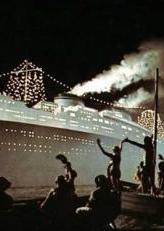Sunday, July 27, 1986.
WORDS ARE UNNECESSARY.
Art speaks for itself, and at Italy's Expo pavilion an attempt is made to let design make a statement about the themes of transportation and communications.
An integrated visual concept, it includes a video-projected film component produced by Rome's archival Istituto Luce. Its title is The Italian Cinema Tells the Story of Italy on the Move, and it consists of four silent, sepia-toned compilations, each one approximately three minutes in length.
Individually, they focus on Travel by Land; by Sea; by Air; and Communications. Each is “a brief journey through the images of the Italian cinema.”
The package is made up of clips from 28 classic features: from director Enrico Guazzoni's 1912 Quo Vadis to Federico Fellini's Amarcord (1973), with Roberto Rosselini, Vittorio De Sica and Luchino Visconti represented in between — and selected newsreel footage.
It is offered as a special treat for serious film buffs.
No special knowledge is needed for the seven-minute, 18-projector slide show that welcomes visitors to Spain's pavilion. Called Tradition and Technology, it provides a workmanlike introduction to the Iberian nation's geography, historical accomplishments and modern industry.
Projected on a horseshoe-shaped screen, the eight-minute production is tightly paced and narrated in American-accented English. It concludes with a reminder that Expo 92, scheduled for Seville, Spain, has for its theme The Age of Discovery and will celebrate the 500th anniversary of Christopher Columbus's "discovery" of the New World.
The above is a restored version of a Province review by Michael Walsh originally published in 1986. For additional information on this archived material, please visit my FAQ.
Afterword: Expo 92, or as was formally known, the Exposición Universal de Sevilla, ran from April to October of 1992. It played host to 112 countries (versus Expo 86’s 54 nations) on a 215-hectare site (v. 70 ha) and, with 41.8 million visitors (v. 22.1 million), went into the record books as one of the largest World's Fairs ever. The organizers deemed it a huge success, playing down the fact that the event cost some €9.3 billion, and left Seville with a debt that lasted for decades.
Perhaps still giddy from Vancouver’s Expo summer, Ottawa commissioned Vancouver-based Bing Thom Architects to design its $40-million Expo 92 pavilion. The government then went back to Colin Low and Tony Ianzelo, the directorial team responsible for Transitions, the National Film Board/IMAX-3D film that had been the hit of Expo 86. The result was Momentum, a spectacular 20-minute short that became the hit of Seville’s fair. The first movie shot in the 48-frames-per-second IMAX HD process, it had people lining up for hours to enjoy a trip to an incredibly scenic Canada.
Not to be outdone, the Spanish government commissioned IMAX producer Greg MacGillivray to make Eureka! La Pasión por Conocer, a film based on historian Daniel J. Boorstin’s 1983 book The Discoverers. The 19-minute film, shown in OMNIMAX in the fair’s Discovery theme pavilion, was the other major movie event of Expo 92. That particular theatre is gone today, razed to make room for a 38-storey housing tower. The distinctive, zinc-clad Canada Pavilion remains, though. When the fair ended, our government donated it to Seville for public use as a trade school.
See also: The eight articles included in this, the third of four Expo 86 special reports, explore the pavilions of:
|
23: Expo 86 EEC/Germany 24: Expo 86 EuroSpace 25: Expo 86 EuroRail 26: Expo 86 Czechoslovakia |
